2009 TOYOTA FJ CRUISER automatic transmission
[x] Cancel search: automatic transmissionPage 2 of 432

TABLE OF CONTENTSIndex
2
1-1. Key informationKeys ..................................... 28
1-2. Opening, closing and locking
the doors
Wireless remote control ...... 30
Side doors ............................ 33
Access doors........................ 36
Back door ............................. 38
Glass hatch .......................... 41
1-3. Adjustable components
(seats, mirrors, steering
wheel)
Front seats ........................... 43
Rear seats ............................ 45
Head restraints ..................... 50
Seat belts ............................. 52
Steering wheel ..................... 58
Anti-glare inside rear view mirror .................................. 59
Outside rear view mirrors ..... 63
1-4. Opening a nd closing the
windo ws
Power windows .................... 66
1-5. Refueling Opening the fuel tank cap .... 68 1-6. Theft deterrent system
Engine immobilizer system ................................ 72
Theft prevention labels (U.S.A.)............................... 74
1-7. Safety information Correct driving posture ......... 75
SRS airbags ......................... 77
Front passenger occupant classification system ........... 90
Child restraint systems ......... 95
Installing child restraints ....... 99
2-1. Driving procedures Driving the vehicle .............. 110
Engine (ignition) switch....... 120
Automatic
Transmission...... 123
Manual Transmission ......... 125
Turn signal lever ................. 127
Parking brake ..................... 128
Horn .................................... 130
2-2. Instrument cluster Gauges and meters ............ 131
Indicators and warning lights ................................. 134
Accessory meter ................. 137
2-3. Operating the li ghts and
wipers
Headlight switch ................. 139
Windshield wipers and washer .............................. 141
1Before driving
2When driving
Page 3 of 432

1
2
3
4
5
6
7
3
Rear window wiper and washer .............................. 143
2-4. Using other driving systems Cruise control ...................... 144
Intuitive parking assist......... 147
Rear view monitor system (vehicles with auto anti-glare
inside rear view mirror) ..... 152
Four-wheel drive system (4WD models with a manual
transmission) .................... 156
Four-wheel drive system (4WD models with an
automatic transmission) .... 158
Active traction control system .............................. 160
AUTO LSD system (2WD models) ................... 162
Rear differential lock system .............................. 164
Clutch start cancel switch (vehicles with a manual
transmission) .................... 167
Driving assist systems ........ 168
2-5. Driving information Off-road precautions ........... 173
Cargo and luggage ............. 178
Vehicle load limits ............... 181
Winter driving tips ............... 182
Trailer towing ...................... 185
Dinghy towing ..................... 195 3-1. Using the air conditioning
system and defogger
Air conditioning system ...... 198
Rear window defogger ....... 204
3-2. Using the audio system Audio system types ............ 205
Using the radio ................... 208
Using the CD player ........... 214
Playing back MP3 and WMA discs ....................... 222
Optimal use of the audio system .............................. 231
Operating the sub woofer ... 234
Changing display color (type B only) ..................... 235
Using the AUX adapter....... 236
Using the steering wheel audio switches
............................. 238
3-3. Using the interior lights Interior lights list ................. 240
• Interior lights..................... 241
• Personal lights.................. 242
3-4. Using the storage features List of storage features ....... 243
• Glove box ......................... 243
• Cup holders (front) ........... 244
• Cup holders (rear) ............ 247
• Bottle holders ................... 248
• Auxiliary box ..................... 249
3Interior features
Page 13 of 432
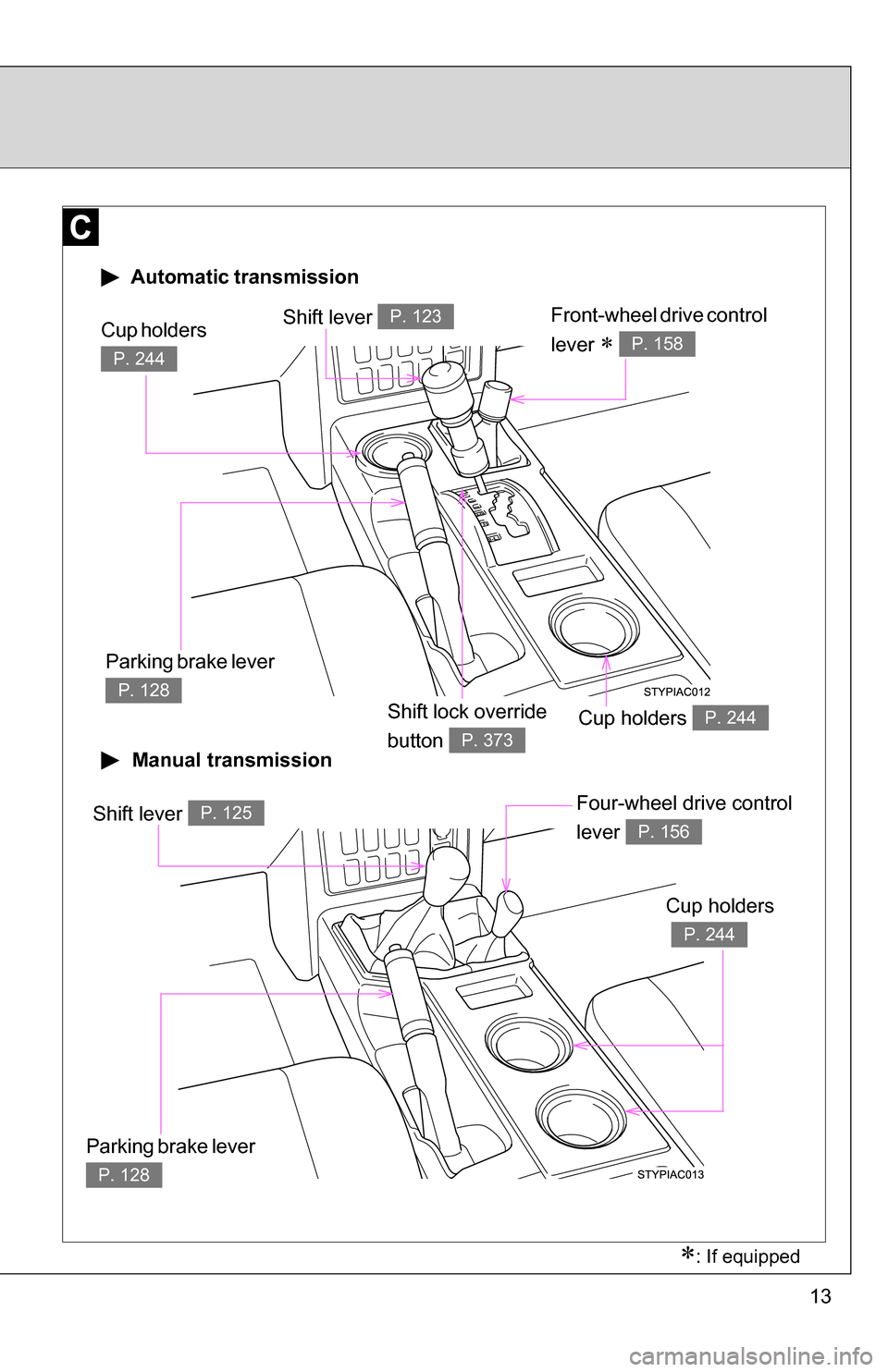
13
Automatic transmission
Manual transmission
Shift lever P. 123Front-wheel drive control
lever
P. 158
Cup holders P. 244
Cup holders
P. 244
Parking brake lever
P. 128
Shift lever P. 125Four-wheel drive control
lever
P. 156
Cup holders
P. 244
Parking brake lever
P. 128
Shift lock override
button
P. 373
: If equipped
Page 109 of 432
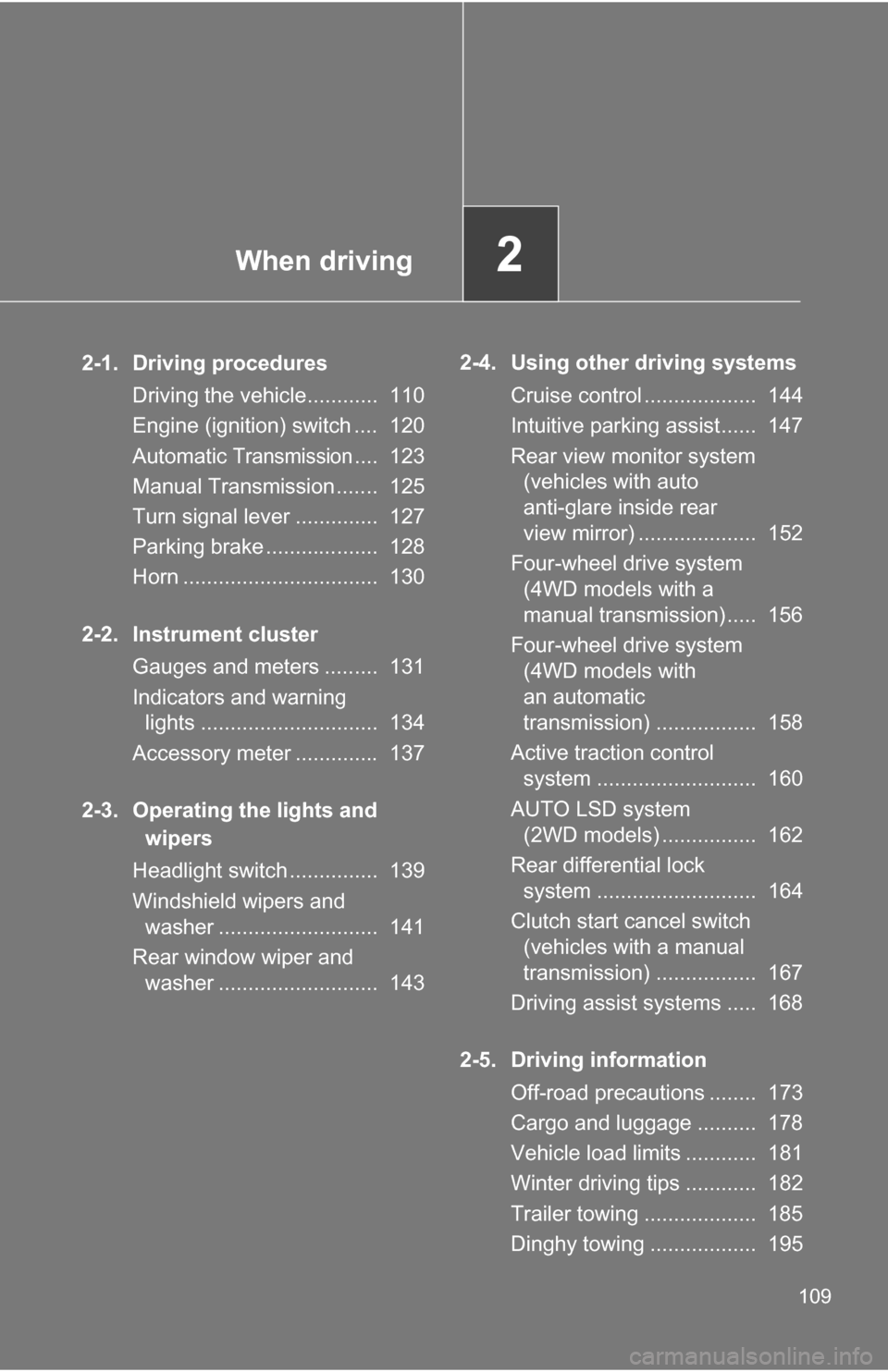
When driving2
109
2-1. Driving proceduresDriving the vehicle............ 110
Engine (ignition) switch .... 120
Automatic
Transmission.... 123
Manual Transmission ....... 125
Turn signal lever .............. 127
Parking brake ................... 128
Horn ................................. 130
2-2. Instrument cluster Gauges and meters ......... 131
Indicators and warning lights .............................. 134
Accessory meter .............. 137
2-3. Operating the lights and wipers
Headlight switch ............... 139
Windshield wipers and washer ........................... 141
Rear window wiper and washer ........................... 143 2-4. Using other driving systems
Cruise control ................... 144
Intuitive parking assist...... 147
Rear view monitor system (vehicles with auto
anti-glare inside rear
view mirror) .................... 152
Four-wheel drive system (4WD models with a
manual transmission) ..... 156
Four-wheel drive system (4WD models with
an automatic
transmission) ................. 158
Active traction control system ........................... 160
AUTO LSD system (2WD models) ................ 162
Rear differential lock system ........................... 164
Clutch start cancel switch (vehicles with a manual
transmission) ................. 167
Driving assist systems ..... 168
2-5. Driving information Off-road precautions ........ 173
Cargo and luggage .......... 178
Vehicle load limits ............ 181
Winter driving tips ............ 182
Trailer towing ................... 185
Dinghy towing .................. 195
Page 110 of 432
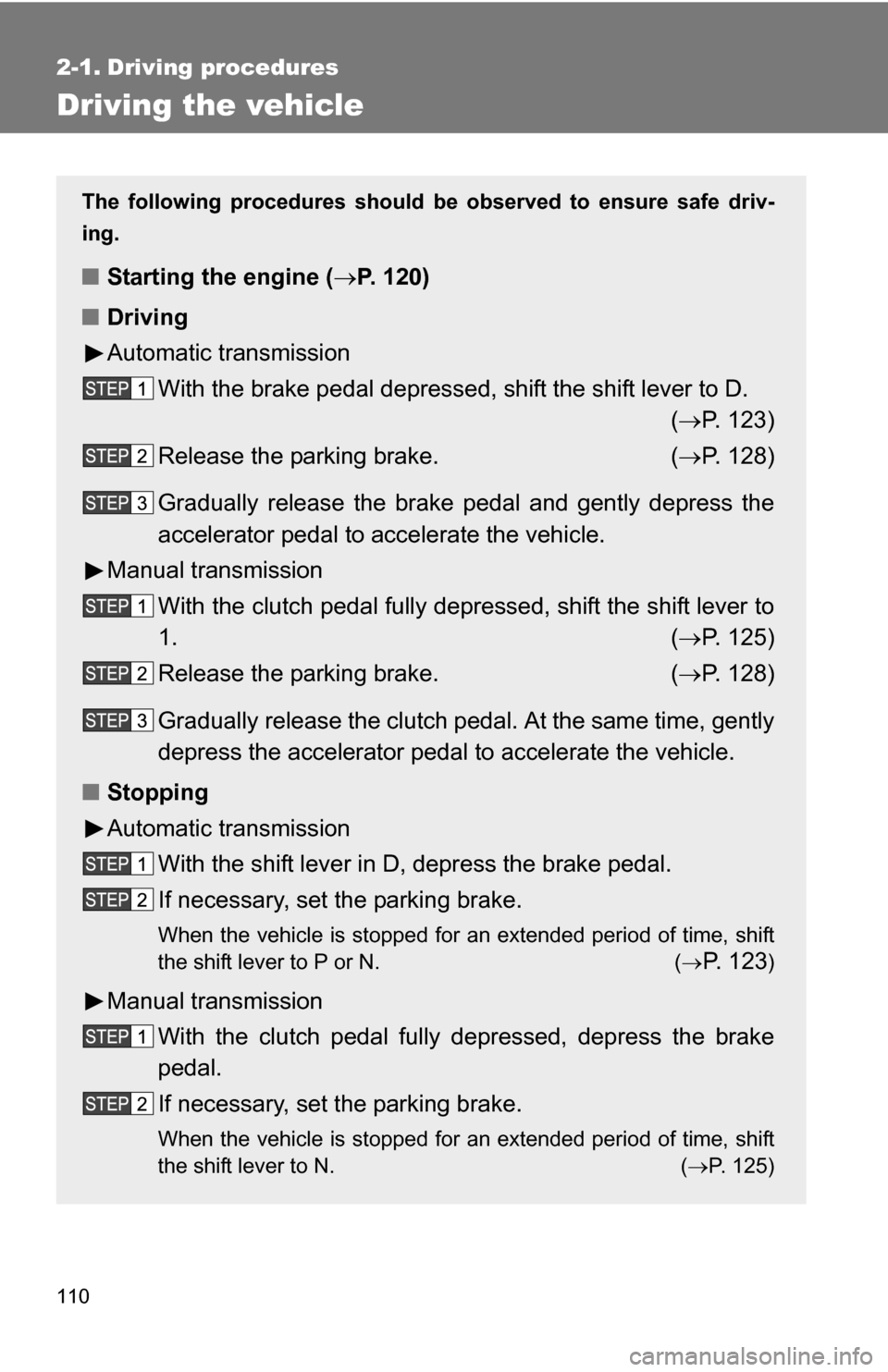
110
2-1. Driving procedures
Driving the vehicle
The following procedures should be observed to ensure safe driv-
ing.
■ Starting the engine ( P. 120)
■ Driving
Automatic transmission
With the brake pedal depressed, shift the shift lever to D. ( P. 123)
Release the parking brake. ( P. 128)
Gradually release the brake pedal and gently depress the
accelerator pedal to accelerate the vehicle.
Manual transmission With the clutch pedal fully depressed, shift the shift lever to
1. ( P. 125)
Release the parking brake. ( P. 128)
Gradually release the clutch pedal. At the same time, gently
depress the accelerator pedal to accelerate the vehicle.
■ Stopping
Automatic transmission
With the shift lever in D, depress the brake pedal.
If necessary, set the parking brake.
When the vehicle is stopped for an extended period of time, shift
the shift lever to P or N. (
P. 1 2 3)
Manual transmission
With the clutch pedal fully depressed, depress the brake
pedal.
If necessary, set the parking brake.
When the vehicle is stopped for an extended period of time, shift
the shift lever to N. ( P. 125)
Page 111 of 432
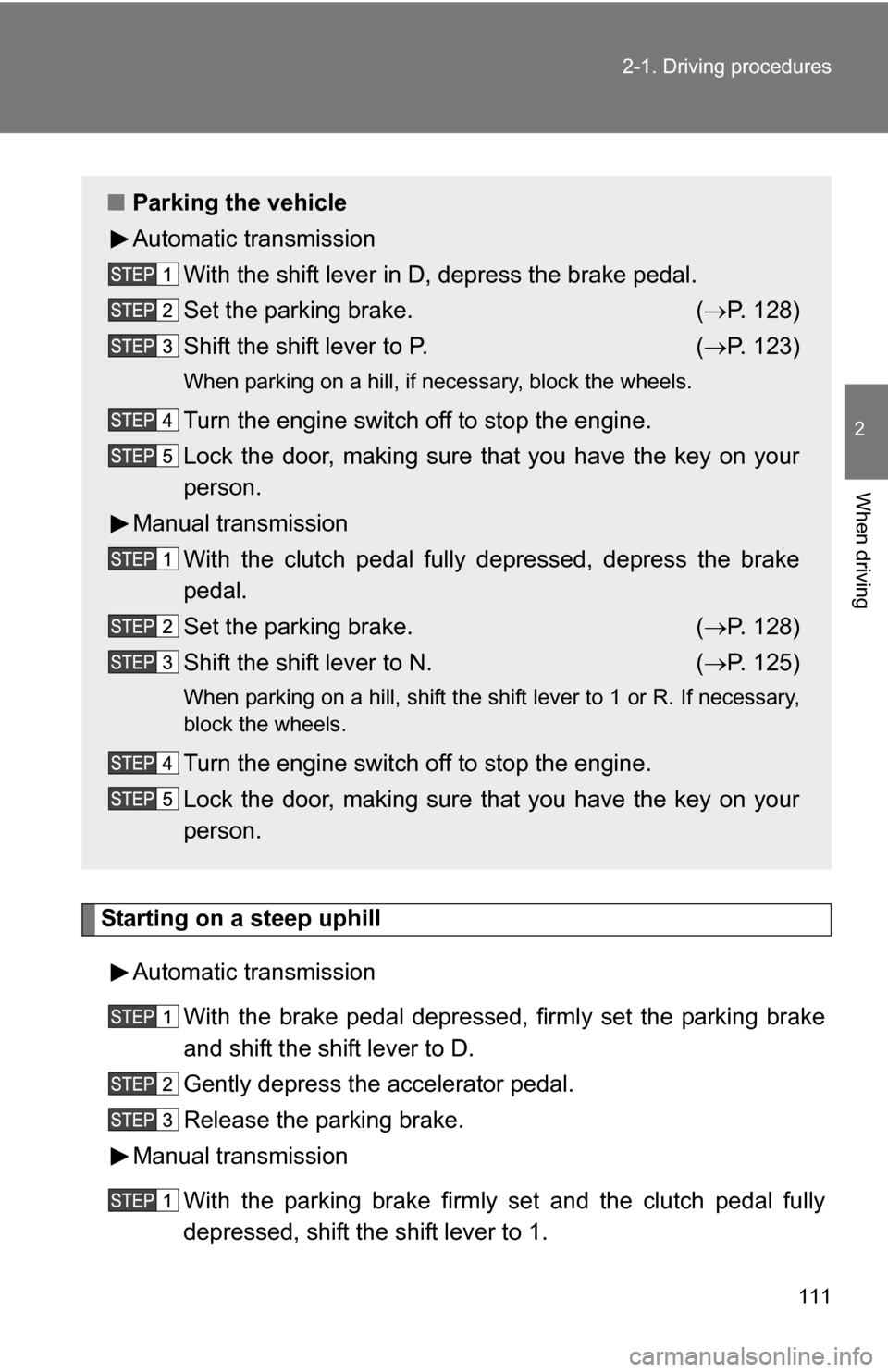
111
2-1. Driving procedures
2
When driving
Starting on a steep uphill
Automatic transmission With the brake pedal depressed, firmly set the parking brake
and shift the shift lever to D.
Gently depress the accelerator pedal.
Release the parking brake.
Manual transmission
With the parking brake firmly set and the clutch pedal fully
depressed, shift the shift lever to 1.
■Parking the vehicle
Automatic transmission
With the shift lever in D, depress the brake pedal.
Set the parking brake. ( P. 128)
Shift the shift lever to P. ( P. 123)
When parking on a hill, if necessary, block the wheels.
Turn the engine switch off to stop the engine.
Lock the door, making sure that you have the key on your
person.
Manual transmission
With the clutch pedal fully depressed, depress the brake
pedal.
Set the parking brake. ( P. 128)
Shift the shift lever to N. ( P. 125)
When parking on a hill, shift the shift lever to 1 or R. If necessary,
block the wheels.
Turn the engine switch off to stop the engine.
Lock the door, making sure that you have the key on your
person.
Page 113 of 432
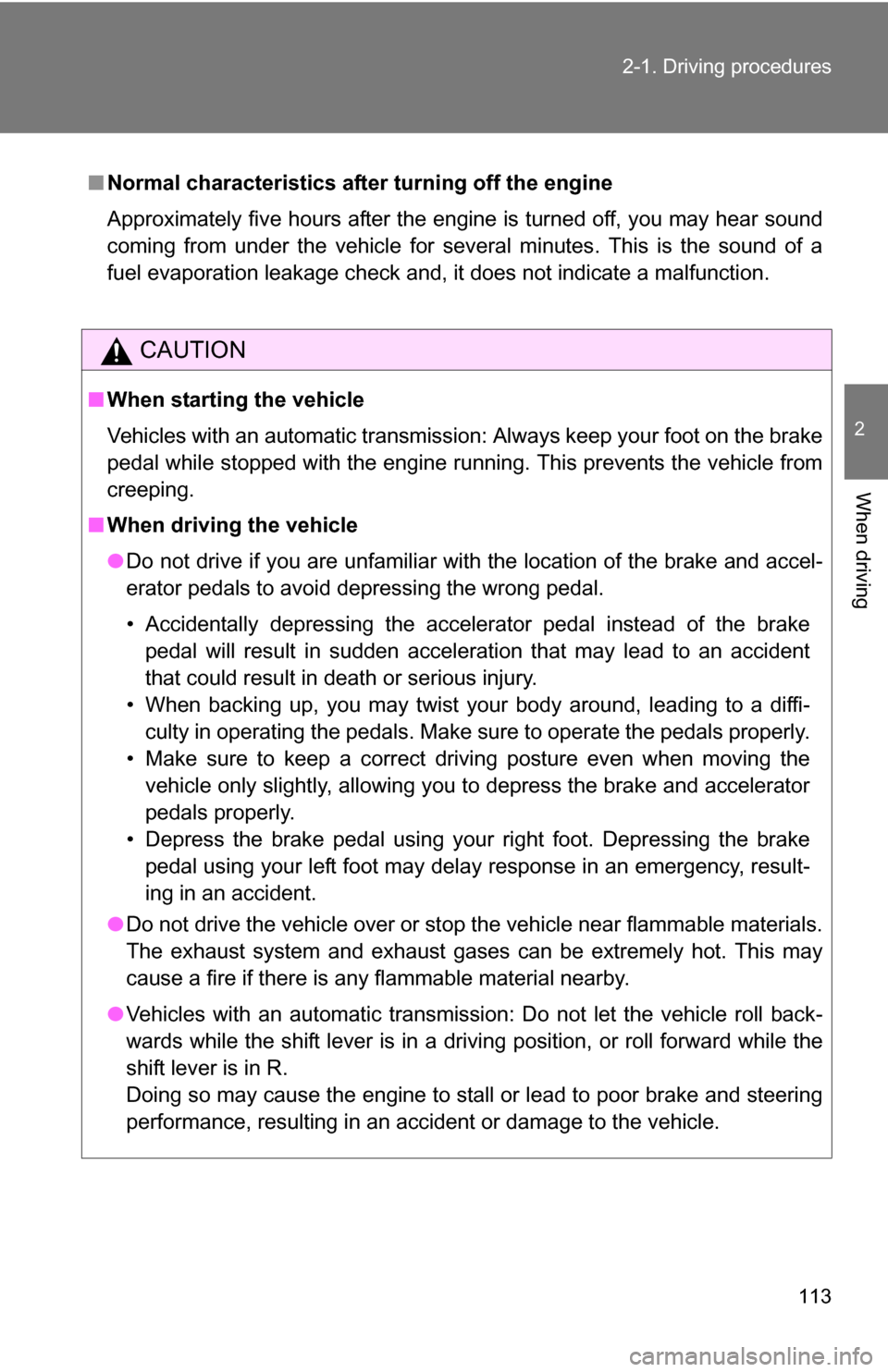
113
2-1. Driving procedures
2
When driving
■
Normal characteristics afte r turning off the engine
Approximately five hours after the engine is turned off, you may hear sound
coming from under the vehicle for several minutes. This is the sound of a
fuel evaporation leakage check and, it does not indicate a malfunction.
CAUTION
■ When starting the vehicle
Vehicles with an automatic transmission: Always keep your foot on the brake
pedal while stopped with the engine running. This prevents the vehicle from
creeping.
■ When driving the vehicle
●Do not drive if you are unfamiliar with the location of the brake and accel-
erator pedals to avoid depressing the wrong pedal.
• Accidentally depressing the accelerator pedal instead of the brake
pedal will result in sudden acceleration that may lead to an accident
that could result in death or serious injury.
• When backing up, you may twist your body around, leading to a diffi- culty in operating the pedals. Make sure to operate the pedals properly.
• Make sure to keep a correct driving posture even when moving the vehicle only slightly, allowing you to depress the brake and accelerator
pedals properly.
• Depress the brake pedal using your right foot. Depressing the brake pedal using your left foot may delay response in an emergency, result-
ing in an accident.
● Do not drive the vehicle over or st op the vehicle near flammable materials.
The exhaust system and exhaust gases can be extremely hot. This may
cause a fire if there is any flammable material nearby.
● Vehicles with an automatic transmission: Do not let the vehicle roll back-
wards while the shift lever is in a driving position, or roll forward while the
shift lever is in R.
Doing so may cause the engine to stall or lead to poor brake and steering
performance, resulting in an accident or damage to the vehicle.
Page 114 of 432
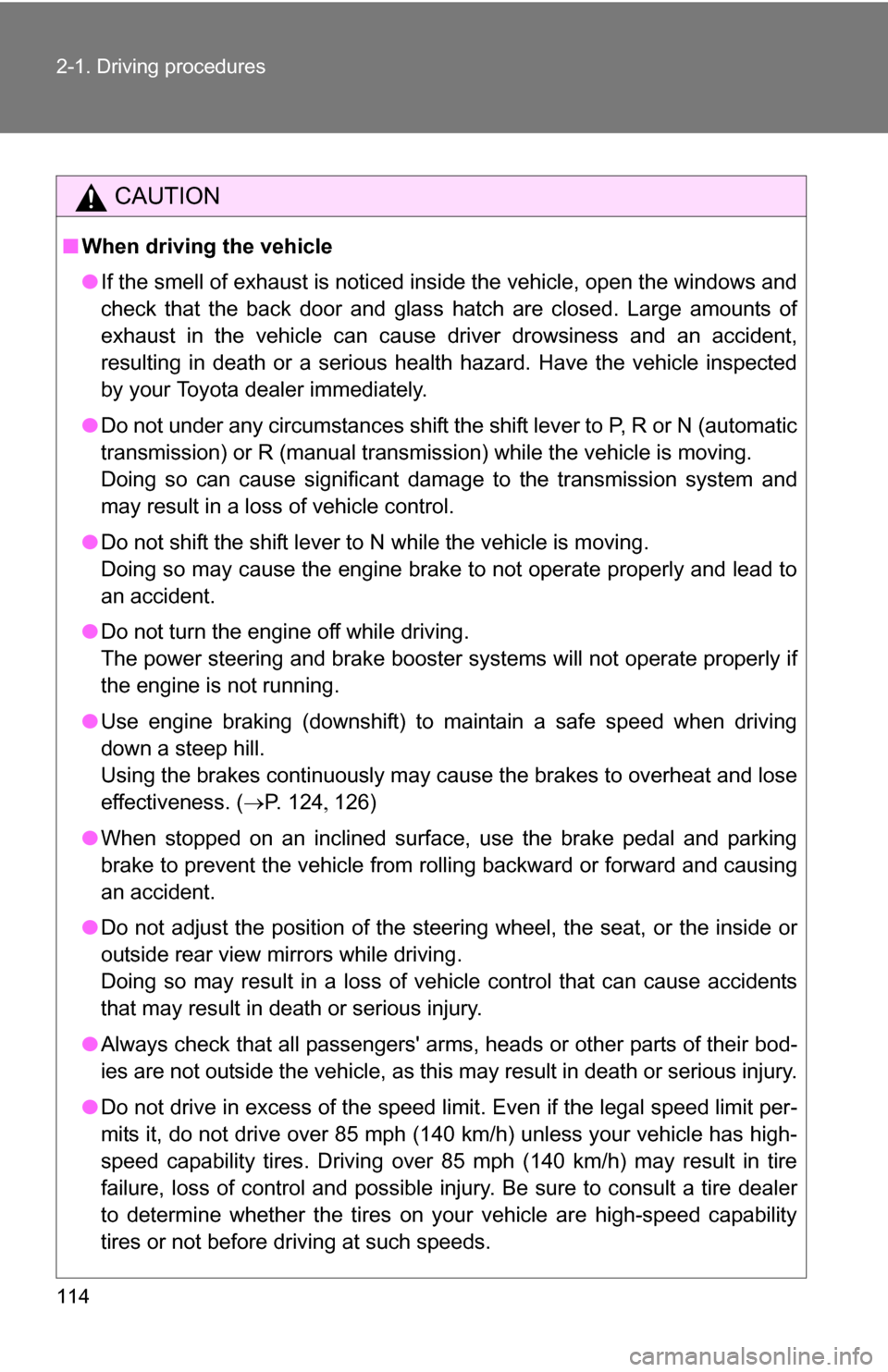
114 2-1. Driving procedures
CAUTION
■When driving the vehicle
●If the smell of exhaust is noticed inside the vehicle, open the windows and
check that the back door and glass hatch are closed. Large amounts of
exhaust in the vehicle can cause driver drowsiness and an accident,
resulting in death or a serious health hazard. Have the vehicle inspected
by your Toyota dealer immediately.
● Do not under any circumstances shift the shift lever to P, R or N (automatic
transmission) or R (manual transmission) while the vehicle is moving.
Doing so can cause significant damage to the transmission system and
may result in a loss of vehicle control.
● Do not shift the shift lever to N while the vehicle is moving.
Doing so may cause the engine brake to not operate properly and lead to
an accident.
● Do not turn the engine off while driving.
The power steering and brake booster systems will not operate properly if
the engine is not running.
● Use engine braking (downshift) to maintain a safe speed when driving
down a steep hill.
Using the brakes continuously may cause the brakes to overheat and lose
effectiveness. ( P. 124126)
● When stopped on an inclined surface, use the brake pedal and parking
brake to prevent the vehicle from rolling backward or forward and causing
an accident.
● Do not adjust the position of the steering wheel, the seat, or the inside or
outside rear view mirrors while driving.
Doing so may result in a loss of vehicle control that can cause accidents
that may result in death or serious injury.
● Always check that all passengers' arms, heads or other parts of their bod-
ies are not outside the vehicle, as this may result in death or serious injury.
● Do not drive in excess of the speed limit. Even if the legal speed limit per-
mits it, do not drive over 85 mph (140 km/h) unless your vehicle has high-
speed capability tires. Driving over 85 mph (140 km/h) may result in tire
failure, loss of control and possible injury. Be sure to consult a tire dealer
to determine whether the tires on your vehicle are high-speed capability
tires or not before driving at such speeds.